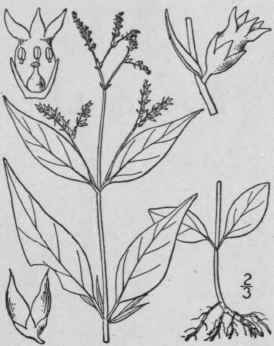3. Cynóctonum J. G. Gmel. Syst. 2: 443. 1791. [Mitrèola R. Br. Prodr. Fl. Nov. Holl. 1: 450. 1810.]
Description
This section is from the book "An Illustrated Flora Of The Northern United States, Canada And The British Possessions Vol2", by Nathaniel Lord Britton, Addison Brown. Also available from Amazon: An Illustrated Flora of the Northern United States, Canada and the British Possessions. 3 Volume Set..
3. Cynóctonum J. G. Gmel. Syst. 2: 443. 1791. [Mitrèola R. Br. Prodr. Fl. Nov. Holl. 1: 450. 1810.]
Herbs, our species annual, with opposite entire membranous leaves, and minute stipules, or the leaf-bases connected by a stipular line. Flowers small, whitish, in one-sided spikes forming terminal or axillary cymes. Calyx 5-parted. Corolla urn-shaped, 5-lobed, the lobes valvate in the bud. Stamens 5, included; filaments short; anthers cordate. Ovules numerous, on peltate placentae; style short, 2-divided below, united above by the common stigma, the divisions becoming separate. Capsule 2-lobed at the summit; carpels divaricate, dehiscent along the inner side. Seeds numerous, small, tuberculate. [Greek, dog-killing.]
About 5 species, natives of warm and tropical regions. Type species: Cynoctonum sessili-folium J. G. Gmel.
1. Cynoctonum Mitrèola (L.) Britton. Mitrewor
Fig. 3328
Ophiorhiza Mitreola L. Sp. Pl. 150. 1753. Anonymos petiolata Walt. Fl. Car. 108. 1788. Cynoctonum petiolatum Gmel. Syst. 2: 443. 1791. Mitreola petiolata T. & G. Fl. N. A. 2: 45. 1841. Cynoctonum Mitreola Britton, Mem. Torr. Club 5: 258. 1894.
Stem simple, or branched near the base, or sometimes also above, glabrous, slender, erect, terete, 1°-2° high. Leaves lanceolate or ovate, petioled, 1'-3' long, 3"-1' wide, acute at both ends, glabrous; cymes terminal and often also in the upper axils, slender-peduncled, the divisions slender, simple or forked; flowers about 1" broad, numerous, sessile or very nearly so; capsule deeply 2-lobed, compressed, the lobes at length widely diverging, acute, dehiscent by a slit in the ventral suture near the summit.
In wet or moist soil, Virginia to Florida, Texas and Mexico. Also in the West Indies. June-Sept.

Continue to:


